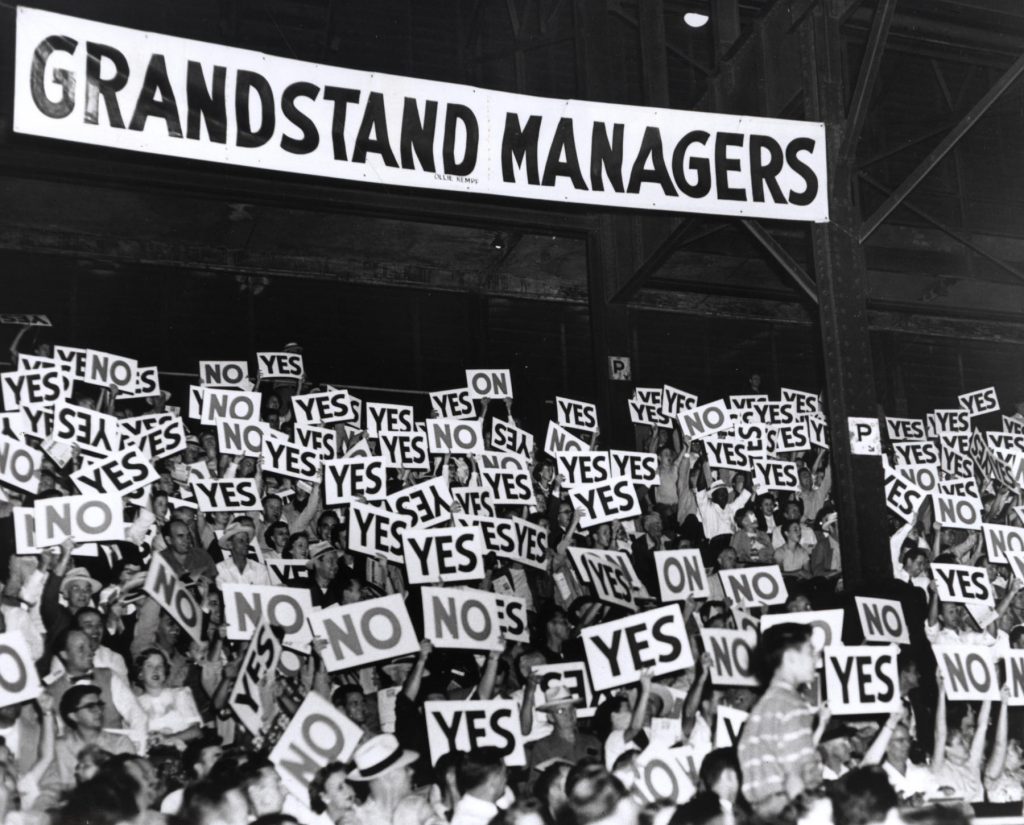Root cause: Teams and technologists are connecting with sports fans like never before
The godfather of sports fan engagement was a baseball showman who handed 1950s fans “yes/no” placards to let them manage a real game, thrilled 1960s fans with a fireworks-spewing scoreboard and, quite likely, would have scowled at the phrase “fan engagement.”
To Bill Veeck, that concept didn’t need big words, just imagination. The maverick owner of three Major League Baseball clubs invented both fan appreciation day and “Disco Demolition Night” as well as pre-game radio broadcasts, phone service for reserve seats, and surprise giveaways of live lobsters and pigeons.
“The fan will have fun,” Veeck once said, igniting the first enduring conversation between a professional sports team and its ticketholders. Today, leagues, teams and tech innovators are expanding the roots of those fan relationships to new ground – from connected stadiums to live-stream apps. They are making a digital difference by tapping into the devotion millions feel for their favorite players and clubs.
FoxTales
“Sports fans are naturally passionate, hence the term ‘fanatic,’” said Josh Hubberman, co-founder and CEO of FoxTales, a California company that gives fans some of the most exciting sports moments – the kind that wind up on Facebook.
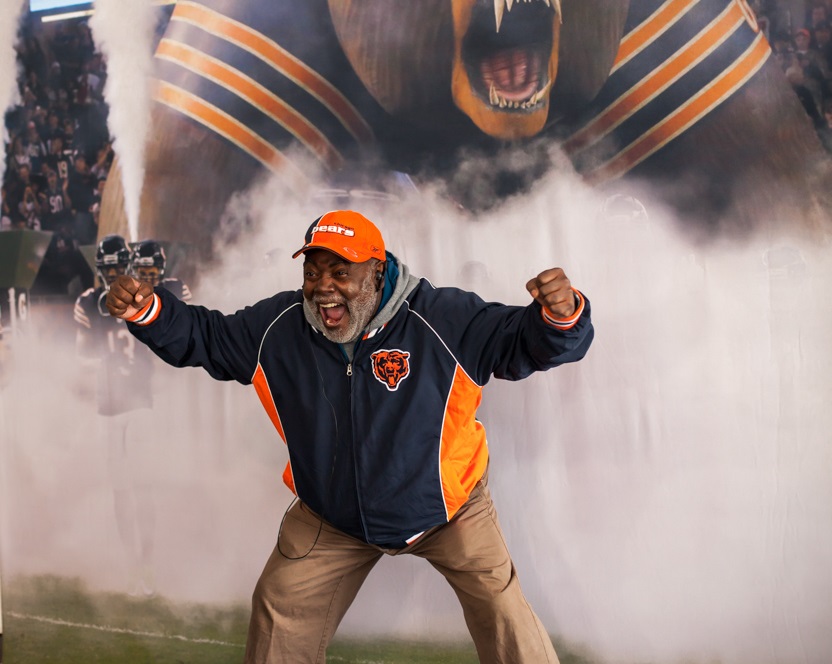
FoxTales creates customized, sharable, interactive-media experiences. The company deploys its cloud-connected hardware at stadiums and sports events, providing a place for fans to pose for immersive and branded portraits, animated gifs, burst gifs, 360 videos and more.
Those same photographed fans then post those images and videos to their social media pages, showing their friends how they virtually dashed onto Soldier Field in Chicago, or how they now adorn a big league baseball card.
The visuals, in turn, are a conduit to a new relationship between the team (or event) and the fan, Hubberman said. For example, when creating a custom baseball card, a fan enters their name, the year they began pulling for the team, the position they play on the field, and the name of their favorite player.
That data gets pushed to Microsoft Azure and shared with the FoxTales client, giving the team new insights and valuable data to help them better understand and, ultimately, communicate with their fans.
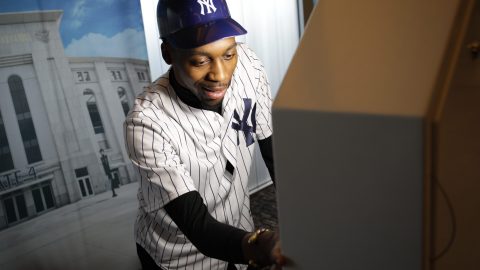
“Every marketer wants to better understand their consumer so they can connect on richer levels and have more meaningful conversations,” Hubberman said. “No consumer who’s at a great event wants to be marketed to; they need to be talked to in their own language. “
FoxTales has created and executed activations across NASCAR, the NFL, Major League Baseball, the NHL, NBA and at Nike retail stores.
“The FoxTales platform allows teams to create seamlessly customizable, timely and emotional media opportunities that connect directly to the center point of a fan’s passion. Because this changes with each game, each season, each new player, fans expect something that is constantly current and always fresh,” Hubberman said.
LaLiga
Fan fervor permeates LaLiga, Spain’s top professional soccer league. LaLiga’s backers – 2.1 billion who watch weekly broadcasts and 1.8 billion who chat on social media – are famous for singing and tweeting about their favorite clubs, including Real Madrid and Barcelona, and about big stars like Lionel Messi and Cristiano Ronaldo.
The fans are demanding access to those signature players and teams, not just during a match, but around the clock. To score big with these backers, LaLiga is delivering innovative experiences that reach far beyond the pitch.
By partnering with Microsoft via a global alliance, LaLiga’s leaders are accessing Microsoft artificial intelligence solutions and cloud services to truly personalize fan interactions. Fans can specify their rooting interests then access only the most relevant content, including videos that reflect their preferences, or stats on their favorite teams or players. Via various digital channels, fans can connect with other LaLiga supporters worldwide, creating interconnected communities.
“Clearly, technology has given fans more ways to interact with their favorite teams and leagues than ever before,” said Alfredo Bermejo, head of digital strategy at LaLiga. “The abundance of apps, social channels and websites is both a challenge and an opportunity. Everyone is looking for cut through.
“At LaLiga, we seek to provide valuable information during matches and, perhaps more importantly, to continue fan engagement between matches and seasons,” Bermejo said. “We provide information and entertainment with various apps, including the popular Head Soccer La Liga 2017 game, and social channels.”
The league is cultivating new fans in new lands, including China where it operates social media channels, Bermejo said. The potency of social media and the popularity of international players, like Japanese footballers Takashi Inui and Gaku Shibasaki, are also growing the LaLiga fan bases in players’ home countries.
SmartCartSVX
Growing the game of golf similarly fuels the work of tech innovator Gil Cowie. Fans who watch PGA TOUR broadcasts on CBS may be familiar with Cowie’s eye-catching device, SmartCart SVX, the world’s first all-weather ultra-bright interactive touch-screen system for television sports broadcasters.
During live events, TV analysts have discussed game performances with competitors while using the mobile cart. The technology allows them to dissect video replays and sift through stats and data that accompanied key moments, giving the fans a true, inside look, said Cowie, CEO and founder of SmartCart Technology Ltd., which has operations in the UK and the U.S.

“Up to now, U.S. sports fans have been seeing sports analysis sometimes using a touch screen, but it’s been done inside the production center studio where it loses the sense of drama and immediacy of the live event. It’s not as compelling or interesting in that context,” Cowie said.
“Now that the touch screen system has left the production studio and gone live into the field, you can take the TV fan closer to the action and to the drama of the event. This let’s them feel more like they’re at the game. This adds a new dimension to TV sports coverage.”
The technology also allows sports commentators to create their own illustrated explainers and visual critiques, sharing their knowledge to tell a deeper story within the game, Cowie said. They can highlight challenges faced by competitors as the drama of the event unfolds, improving fan experience.
SmartCart SVX was developed to use the Microsoft Cloud to pull, sort and analyze content. Further enhancements are planned for this year, Cowie said.
One of the customizable carts will be deployed to every 2017 PGA TOUR event on the CBS Sports schedule. Another has been deployed to Wimbledon for use throughout the 2017 tournament.
Broadcasters used earlier versions of the technology for the European Tour (golf), Ryder Cup (golf), UEFA Champions League (soccer), Premier League (soccer), NFL International Series, Formula 1 racing and more.
“I describe it as: ‘Get inside the game.’ You get that unique viewpoint – from the competitors themselves reviewing their performance on the screen and talking to the fans who are watching on TV,” Cowie said. “That’s something broadcasters have not had before. It engages fans much more with what’s going on in the game.”
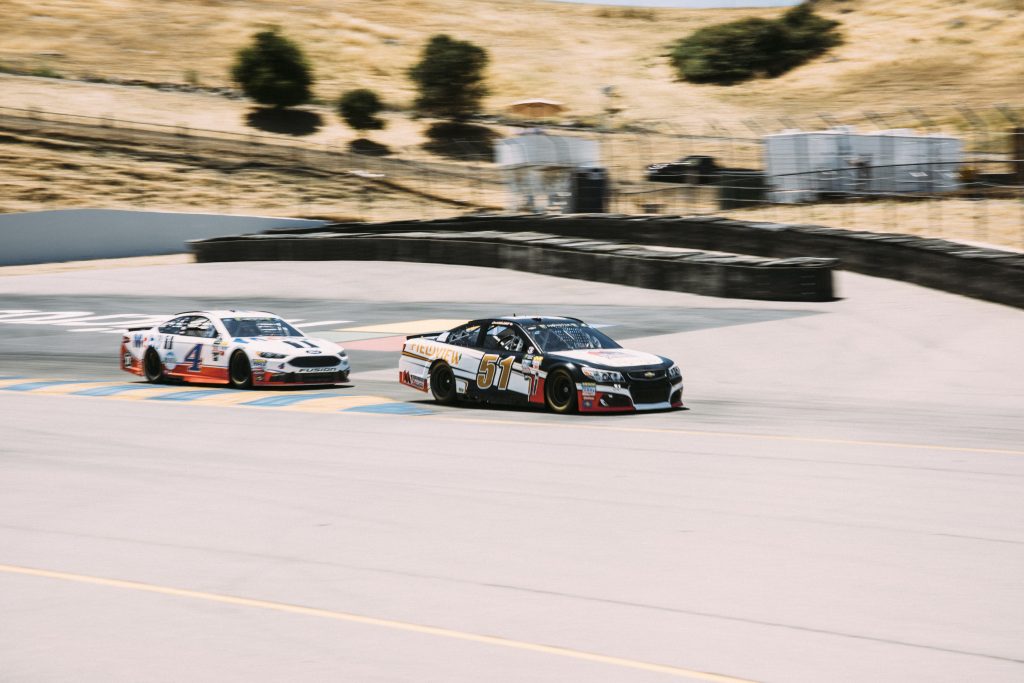
NASCAR
Inside a NASCAR race, fans know what’s going on: an urgent quest by speed-hungry teams to skim fractions of seconds off lap times and pit stops.
That precious sense of the clock also infuses the focus of NASCAR’s race-day officials who steadily monitor every inch of the action to make sure the chase is fair and safe – and that drivers get back to full speed as soon as possible following a caution flag. The race management app offers a vision to make that happen.
The app is built on Windows 10 and leverages Microsoft’s Azure cloud platform to merge six data categories into one platform: historical data, timing and scoring, pit road officiating, video replay and car positioning.
NASCAR also integrated Microsoft Surface Dial into the app. The hardware tool is the size of a hockey puck and works with Microsoft Surface Studio and Surface Pro to activate hidden software features, freeing up hands for other tasks. NASCAR race officials are using Surface Dial in the app’s “infraction video” feature, which captures video to monitor pit stops for violations.
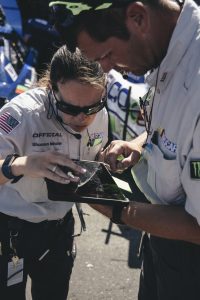
“Sorting out penalties sooner saves seconds – a pursuit all race fans admire,” said Betsy Grider, managing director of technology development at NASCAR.
Case in point: A crash that leads to a caution flag and a full-race slow down. The cars may circle in a passive pack for dozens of laps.
“After you confirm there are no medical issues that need to be addressed, the focus immediately shifts into: How do we get back to racing as fast as we possibly can?” Grider said. “Because a long lull during a caution can be correlated to TV ratings.
“The race control team is feeling pressure to get the cars back on the track, to get back to exciting green flag racing for fans. The Race Management app empowers our officials and directors to make faster decisions,” Grider said.
The Connected Stadium
To make fans feel fully at home in their shoulder-to-shoulder fanaticism, the Amsterdam ArenA is transforming into a “smart stadium,” where the futuristic vision starts with guests arriving in self-driving cars that are parked for them.
It gets even easier from that point. Fans would walk into the arena not by flashing a ticket but by pausing for a facial recognition scan at entry points. Then, an artificial intelligence solution would guide them straight to their seats.
This the “smart city” concept now occupying the minds of officials at Amsterdam Arena, home to AFC Ajax, a top soccer club. They plan to make this technology a reality in three years when they host the 2020 UEFA European Football Championship. Arena directors plan to use the Microsoft Cloud to connect the stadium, including equipping sensor to thousands of objects like gates, chairs and stairs to monitor their use and optimize their management through the Internet of Things.
“My dream,” said Henk van Rann, director of facility management, “is to make the best fan experience here – before, during and after events.”
Over the next few months, the Transform blog will feature several storylines inspired by companies now making a digital difference. This is the third in the series
Top image: More than 1,000 St. Louis Browns fans became “grandstand managers” on Aug. 24, 1951 when club owner Bill Veeck gave them “yes/no” cards to make the in-game decisions. St. Louis won 5-3. Photo courtesy of the National Baseball Hall of Fame Library.

